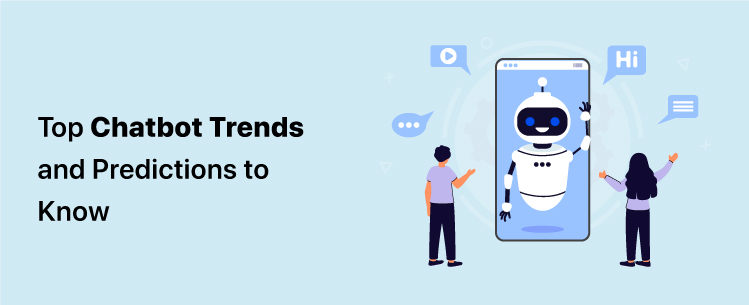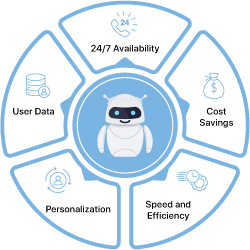
Quick Summary:
As technology grows, chatbots are becoming an essential resource for companies prioritizing superior customer service. Over the past several years, they’ve progressed from basic question-answering computers to sophisticated chatbots with the ability to interpret natural language and make tailored suggestions. The article discusses the latest chatbot trends in 2024 and beyond. Explore the exciting chatbot trends in 2024.
What is a ChatBot?
Chatbots are computer programs that can understand and simulate human conversations using artificial intelligence (AI) and natural language processing (NLP).
AI powers the chatbots, and they are trained to understand complex questions and provide accurate answers. Using NLP, chatbots can understand the user’s intent and respond accordingly. Businesses use bots for customer services, marketing, and operations. Chatbots are becoming an essential part of online businesses.
Benefits of Using Chatbots for User Experience Improvement

24/7 Availability: Chatbots can offer 24/7 services with immediate responses to user queries. Thus, it helps businesses enhance the user experience and boost loyalty.
Personalization: It is possible to train chatbots to personalize user interactions using NLP and AI. They can study and remember user interactions, preferences, and behavior to give personalized responses. Thus, chatbots can deliver human-like experiences.
Speed and Efficiency: Chatbots can handle multiple queries and respond faster than human support staff. It helps improve productivity and efficiency.
Cost Savings: With chatbots, the need for human staff is reduced as the bot can automate many operations. So, businesses can save on staff salaries, especially for routine queries and operations. Businesses can invest more in other areas to grow the business or improve user experiences.
User Data: Customer data is highly valuable for businesses to deliver personalized user experiences. Chatbots collect user data, such as their preferences and behavior. Businesses tailor their services using insights into user behavior.
How to Design a Good Chatbot Experience?
With careful planning and a reliable chatbot development company, designing a good chatbot experience is possible. Here are some steps you can follow to create a successful chatbot experience:
- Planning: The first step is to know the purpose and scope of your Chatbot. Consider answering the questions like what problems the bot aims to solve. What is the target audience and the budget? Also, think of the conversations the bot will indulge in.
- Consider Technical Specifications: The next step is to decide on the technical specifications, like the development platform, features, and programming languages.
- Develop Chatbot Voice: You can design a unique personality and voice for your chatbots. You can design the tone, voice, and personality that aligns with your target audience. The voice and tone of the Chatbot should also resonate with your brand.
- Design Interface: The Chatbot is designed to assist customers when needed. The interface of the bot should be friendly and customer-centric. The bot should provide clear instructions and answers to user queries.
- Implement Natural Language Processing: Natural Language Processing (NLP) allows the Chatbot to understand and interpret the user’s language. Ensure the Chatbot can handle different languages easily and respond to user queries.
- Test and Iterate: The next crucial step is thoroughly testing the bot for errors, loopholes, or software glitches. You can also test the Chatbot with real users to get feedback for further improvements.
What to expect from chatbot technology trends in 2024
Increase in the use of chatbots
Customers now rely heavily on conducting business online, whether for research, purchases, or assistance. Customers have come to expect all companies to have chatbots because of the convenience they provide (answering questions instantly and being available around the clock). This is why chatbots are gaining popularity in customer service, business development, and other areas.
AI-powered chatbots have several applications for organizations, including proactive communication with website visitors, message channel updates, resolution and alternative suggestions depending on consumer intent, and more. Companies may use these to help them compete in the marketplace and provide their consumers with the best shopping and support experiences.
Natural Language Processing (NLP)
NLP enables chatbots to understand and interpret human languages. Natural Language processing is thus a major component of chatbots. NLP advancements will allow chatbots to recognize and respond more precisely and accurately to user queries.
Fueling the evolution of messaging app features
More than 300,000 chatbots are now active on Facebook Messenger. Messenger apps like WhatsApp, Apple’s Business Chat, Facebook or Instagram, and others increasingly incorporate chatbots into their user experiences.
Businesses may use messaging platforms to maintain contact with their clients via their preferred methods of communication. This increases interaction with the brand and ultimately leads to brand loyalty.
When chatbots are integrated with messaging systems, businesses may increase customer satisfaction, sales, focused marketing efforts, and potential leads.
Managing a brand’s visibility across several communications platforms is a time-consuming process. WhatsApp, Gmail Messages, Apple Professional Chat, Line, Telegram, Messenger on Facebook, and Instagram are just some of the messaging platforms that businesses can include chatbots.
All the conversation requests from various channels may be handled in a single window, saving you the trouble of switching between several tabs.
Increased Use of voice-activated virtual assistants
There will be a $26.8 billion voice and speech recognition market in 2025. Voice bots are becoming increasingly common as conversational AI develops. It’s also been shown that 71% of clients conduct internet searches utilizing voice input rather than typing.
Customers increasingly utilize speech bots for various tasks, including scheduling reminders, making purchases, preparing meals, and keeping up with the news.
Use of Chatbots for Enhanced Customer Satisfaction
The role of chatbots in enterprises has evolved from simple greetings to conversation starters, behavior influencers, and response generators, depending on user input.
Every day, we come across a new and innovative method in which a company has employed chatbots to provide better customer service. Chatbots can do a lot more than they could even a few years ago, thanks to either in-house development or the usage of third-party connectors to enable new and enhanced features.
Certain corporations, such as PayPal and Mastercard, have already implemented chatbots to assist customers with questions about their accounts.
Easier Customer Feedback
Businesses can Increase their chances of gathering client feedback with a simple auto-feedback form that appears on pre-programmed occasions. It’s immediate and doesn’t require the user to leave the site to check their email or phone, as was previously the case. Chatbots may determine for themselves if a discussion went well, while analyzing collected data can provide areas for development.
Simulate human-like conversations
In their infancy, chatbots were limited in their capabilities and frequently frustrated users by being stuck in a never-ending “chatbot loop.” They only responded to certain keywords without considering the sentence’s broader meaning.
Chatbots are now programmed using artificial intelligence (AI), natural language processing (NLP), and machine learning (Ml) to indulge in human-like conversations. These chatbots can infer user intent from prior interactions and provide appropriate responses.
Personalized Customer Service
The fact that chatbots sound artificial and a human-like interaction was a major hurdle when they were initially introduced. No longer is this the situation.
The customer service provided by chatbots has improved thanks to natural language processing. Chatbots can retrieve information about a user’s past interactions and provide recommendations or suggestions that are unique to that user.
In the past, chatbots could only respond with a simple YES or NO to a customer’s inquiry about an item’s availability on a store’s website. However, modern chatbots can mimic human conversation by providing additional information, such as, “Hey, unfortunately, that item is not in stock; however, here are a few similar options that other customers have bought.” And if this is a returning client, the Chatbot may ask, “Hey, we don’t have that item in your size currently; would you like us to inform you when it’s back in stock?”
These two changes will majorly impact your customers and your bottom line.
Integration with Social Media
People are using social media to engage with businesses, as well as their friends and family. Customers now use social media to purchase, provide product reviews, and submit customer service requests. To understand customer behavior and social media activity, several companies have begun implementing chatbots to improve the support experience for their customers.
By using Artificial Intelligence to evaluate massive amounts of data, brands can quickly and easily uncover emerging themes and user behavior. Social media chatbots will offer a personalized way for customers to engage with businesses.
Conversational commerce
Conversational commerce is a recently growing trend. It involves using chatbots or conversational interfaces to sell products or services. More businesses are integrating chatbots and AI into their operations and marketing to provide a better customer experience.
Easier Chatbot deployment
Integration of chatbots into your existing chat or message infrastructure does not require you to learn any complex new code. Thanks to no-code bot generators, you can now have a chatbot up and running on your website in minutes. With this, businesses can rapidly implement and start reaping the benefits of chatbots for customer service, sales, and marketing.
Tips for Implementing the Latest Chatbot Trends in 2024
- Follow the Latest Technology: Chatbots are based on AI/ML, NLP, and other latest technologies. Technology trends change rapidly, and it is essential to keep up with them to stay relevant. Thus, you can build and update chatbots with the most up-to-date technology and provide the best possible user experiences.
- Using Natural Language Processing: Natural language processing (NLP) is a key technology for chatbots. Look for the latest improvements in the technology and implement them in the bots. This way, you can ensure more accurate responses from the bot.
- Utilize Data: Data is the essential fuel to maintain and improve chatbot performance. Gather data on user interactions and analyze what works and what doesn’t. Use this data to optimize your Chatbot and provide better experiences.
Conclusion
A successful chatbot should have a simple interface that leads the user naturally through the discussion. It needs to be individualized for each user by considering their likes and dislikes to offer relevant suggestions and answers. A chatbot’s ability to follow the flow of a conversation and respond appropriately is only half the battle; it also needs to integrate with other channels like email, social media, and phone to ensure a consistent customer experience.
Chatbots are expanding and evolving rapidly and will have a significant influence in 2024 and beyond. Improvements in AI and NLP, integration with voice assistants, and the creation of chatbots that can speak several languages are all examples of the magical power of chatbots.
If you plan to build a chatbot, ValueTree can help you out with an experienced team of AI engineers and programmers. Our team leverages the most advanced technologies to build effective bots. They update their knowledge of the latest technologies and leverage the same to deliver custom chatbot development services that match the current user demands.
Contact us today to discuss your bot development requirements.
